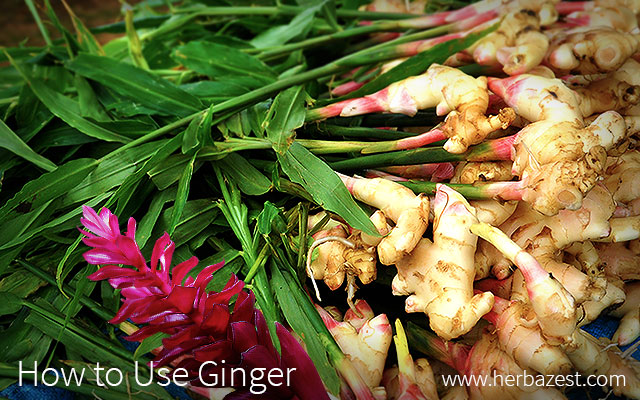Ginger is best known for its applications in traditional and folk medicine as a result of its anti-inflammatory, anti-emetic, and antispasmodic effects.
Although the rhizome or root is the part most often used for culinary and medicinal purposes, the usable parts of ginger include the majority of the plant. There are benefits to be obtained from the ginger stem, leaves, and flowers. In fact, these parts of different ginger species play important roles in cultures all around the world.
How to Use Ginger Root
There are many uses ginger is good for, mainly due to its high levels of gingerols, shogaols, and zingerones, responsible for most of ginger health benefits. The dried ginger root possess high levels of shogaols, which are very potent and can help to relieve many gastrointestinal issues. However, the medicinal uses of ginger include its consumption as an infusion, tincture, or syrup. Moreover, ginger supplements are also available as a result of their uses in easing nausea and arthritis pain.
Ginger rhizome is commonly called "root". However, while both roots and rhizomes grow underground, the rhizome is actually an underground stem that grows horizontally in the earth.
The ginger root is commonly used as a flavoring agent in the food and beverage industry, and eating fresh, raw ginger is a popular practice. When ginger is cooked, its gingerols are transformed into zingerones, which do not have quite as potent medicinal properties, but are still effective in easing pain and nausea.
Another popular method of consuming ginger is through ginger tea. However, the taste of the Asian root is often described as pungent, so when drinking ginger as an infusion its strong flavor is usually masked adding honey or sugar.
Ginger is also used as an additive and active ingredient in the cosmetic industry, where it is used as a skin conditioning agent, a moisturizer, and a sun blocker, as well as a healing and shining agent. Some products that can include ginger as an ingredient include creams, soaps, perfumes, body washes, bath salts, hair serums, and lip balms.
How to Use Ginger Leaves
It is lesser known that ginger leaves have a long history of medicinal and culinary use. In many countries around the world, the different varieties of ginger are often used to wrap fish and meat to add flavor when cooking.
In Thailand, ginger leaves are sometimes consumed in salads. The leaves of some ginger species can be cooked as a vegetable or even used as a cosmetic powder.
Most often in Asian countries, the leaves of different ginger species are eaten or applied in order to treat specific ailments such as swelling, headache, backache, and stiff and sore joints.
How to Use Ginger Stems and Flowers
Besides the leaves and root, the young stem of the ginger plant can also be used as a spice or condiment. In east Malaysia, the centers of young ginger shoots are consumed by the indigenous as a condiment or raw or cooked vegetable.
The flowers of some ginger species, are also edible. In Japan, the ginger species Zingiber mioga is grown specifically for the flower bud, which can be consumed raw or pickled.
How to Use Ginger Plant
Most recently, growing ginger for ornamental purposes, as well as many genera in the Zingiberaceae family - such as Alpinia, Curcuma, and Zingiber - has become popular because of its beautiful leaves and flowers.
While ginger is primarily used for medicinal purposes or as a spice, the way it is prepared and consumed varies all around the globe. It may be surprising to find that all parts of the ginger plant are used for different purposes. Furthermore, the great variety of ginger species have allowed for much diversity in its use across cultures as a decorative ornament, flavoring agent, and medicinal supplement.
Sources
- Advances in Therapy, Ginger: history and use, 1998
- Free Radicals and Antioxidants, Antioxidant properties of ginger leaves: An Overview, 2011
- ICAR Agropedia, Varieties of Ginger
- Plant Physiology, Functional classification, genomic organization, putatively cis-acting regulatory elements and relationship to train loci, or sorgum genes with rhizome-enriched expression, 2006
- The Environmental Working Group, Products containing ZINGIBER OFFININALE | ZINGIBER OFFICINALE
- Encyclopedia of Herbal Medicine, p. 155
- FAOSTAT, Statistics for Ginger Production
- MedlinePlus Herbs and Supplements, Ginger
- USDA Nutrient Database, Ginger root, raw
- American Cancer Society, Ginger
- Journal of Medicinal Food, Anti-inflammatory properties of red ginger (Zingiber officinale var. Rubra) extract and suppression of nitric oxide production by its constituent, 2010
- Medicinal Plants of the World, p. 349
- Journal of Pharmacy and Pharmacology, Immunomodulatory activity of Zingiber offininale, Salvia offininalis L. and Syzygium aromaticum L. essential oils: evidence for humor- and cell-mediated responses, 2009
- International Journal of Preventive Medicine, Anti-Oxidative and Anti-Inflammatory effects of Ginger in Health and Physical Activity, 2013
- Kew Royal Botanic Gardens, Zingiber offininale (ginger)
- University of Maryland Medical Center, Ginger




